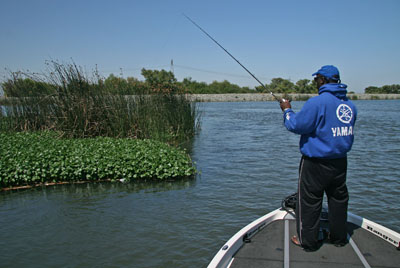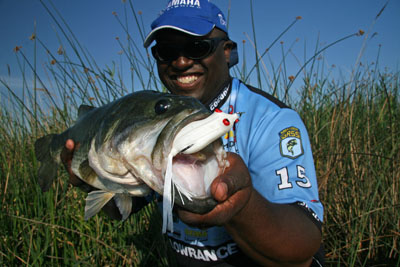CALIFORNIA DIVERGENCE
Top Two Golden State Fisheries Offer Different Opportunities
California owes its “Golden State” nickname to the 1848
discovery of the gilded metal streaking through its mountains. However,
anglers prospecting the state’s western waters will find a motherlode
of largemouth bass action in two distinctly different fisheries linked
by rod-bending revelry.
 Draining California’s Central Valley, the Sacremento and San
Joaquin rivers collect dozens of smaller rivers and streams, ultimately
converging to form a habitat-rich region known collectively as the
Cal Delta. From the Delta’s upper end, trailer a boat about two
hours north and you’ll find the gem of Lake County – the
43,785-acre mountain oasis known as Clear Lake.
Draining California’s Central Valley, the Sacremento and San
Joaquin rivers collect dozens of smaller rivers and streams, ultimately
converging to form a habitat-rich region known collectively as the
Cal Delta. From the Delta’s upper end, trailer a boat about two
hours north and you’ll find the gem of Lake County – the
43,785-acre mountain oasis known as Clear Lake.
Both areas host native bass, but the introduction of heftier Florida-strain
largemouths a few decades ago sent this fishery right through the roof.
Now, anglers flock to these waters with realistic expectations of high
numbers and really big fish.
“Clear Lake is without a doubt the bass capital of the west,
with the Delta a close second,” said Ranger Boat dealer Scott
Green of Santa Rosa. “Tournament weights prove that this fishery
is alive and well 12 months a year. It’s common to catch (a 5-fish
limit weighing) 20-30 pounds on any given day and in the pre-spawn,
if you do not have 25-plus pounds you are not in the game.”
Tournament pro
Matt Newman of Agoura Hills, Calif. said Delta stats prove likewise. “The average fish is about 4 pounds, but you
will need 30-pound (limits) to do well there in a spring tournament.
It’s not uncommon to see several ‘teen’ fish weighed
in a tournament.”
Delta guide Bobby
Barrack of Oakley, Calif. said that despite frequent meteorological
mayhem, these western wonderlands hold staggering potential. “Two
weeks out of each month, (these waters) exceed all expectations that
you ever had. This area is very influenced by the weather because we’re
so close to the Pacific Ocean, but when it’s on, don’t
throw anything less than 20-pound test.”
Convenient facilities
and straightforward access points make both fisheries popular destinations
for bass fanatics – separately,
or in tandem. Here’s a look at what to expect from each area.
DELTA DELIGHTS
 Vast habitat, bountiful
forage and lots of fish – that’s
a pretty good assessment of the Cal Delta. Predator and prey lack not
for range, as the Delta region covers some 600,000 acres stretching
roughly from Sacramento, west to San Francisco Bay and then South to
about Manteca.
Vast habitat, bountiful
forage and lots of fish – that’s
a pretty good assessment of the Cal Delta. Predator and prey lack not
for range, as the Delta region covers some 600,000 acres stretching
roughly from Sacramento, west to San Francisco Bay and then South to
about Manteca.
“The size of the delta is nuts,” Newman said. “I
have been fishing there quite a bit for the last five years and I would
still get lost if I didn’t have GPS.”
Hundreds of miles
of rip rap shoreline complemented by grass beds and a tall species
of sedge known as tules (pronounced “too-lees”)
present a largemouth fishery that’s simply astounding – particularly
when spring finds hordes of huge female bass invading the shallows
to release the next generation of black bass.
Throughout the
year, productive spots range far and wide, but key Delta areas include
Frank’s Tract State Recreation Area (north
of Bethel Island), Big Break to the southwest and Little Manderville
Island to the east. Bass certainly have their preferences, but the
area’s 12-month growing season disperses great numbers of hungry
fish all across this region.
Put it this way,
most tournament anglers fish with hookless lures during practice
days to avoid spooking – or “sore-lipping” – fish
they will need during competition. However, Newman looks forward to
jacking a few jaws prior to each Delta event.
“I always stick fish during practice days (on the Delta) because
there are so many fish it just doesn’t matter,” he said. “I
have to find out where the biggest fish are congregating.”
 Newman, who has
pulled bass up to 12-pounds from the Delta, said visitors will appreciate
the region’s tactical diversity. “There
are very few places in the west (in which) you can use any fishing
method and do well. In the Delta, you can dropshot 6-pound line in
clear water or flip jigs with 65-pound braid in the same day.”
Newman, who has
pulled bass up to 12-pounds from the Delta, said visitors will appreciate
the region’s tactical diversity. “There
are very few places in the west (in which) you can use any fishing
method and do well. In the Delta, you can dropshot 6-pound line in
clear water or flip jigs with 65-pound braid in the same day.”
Ish Monroe, a Bassmaster
Elite Series pro from Hughson, Calif. sticks with a quintet of Delta
baits that he’ll fish year-round: a Sweet
Beaver (California 420 and watermelon red flake colors) Texas rigged
with ¼- to 1 ½-ounce tungsten bullet weights, a jointed
swimbait, shallow running crankbaits (red), Snag Proof Ish’s
PHAT Frog (white), and lipless crankbaits (red).
Barrack, for whom
the Snag Proof “Bobby’s Perfect Frog” is
named, likes throwing the amphibian imposter into pockets within sparse
tules where fallen vegetation forms a “roof” for bass.
Using the cicada, brown bullfrog or Tweety (yellow/black) colors, he’ll
make short casts in which he expects most of his reaction strikes to
occur within a couple feet of where the lure hits. Barrack also likes
rattling baits, ½-ounce white chartreuse spinnerbaits with
gold and silver willow leaves and 6-inch watermelon red Senkos rigged
Texas style with weighted shank hooks.
GO WITH THE FLOW
At its western end the Delta links to Suisun
Bay (an upper arm of San
Francisco Bay) through the Carquinez
Strait, thereby creating a tidal environment. That means daily
water movement will reposition forage and the predators that leverage
these changes for feeding opportunities. Rising tides enable bass
to reach deep into vegetation where minnows and crawfish hide, while
falling water pulls baitfish past rocky edges, island tips and other
ambush points.
“It’s current and tide that positions our fish,” Barrack
said. “The bass know exactly when their food is available.”
Newman describes
the importance of working with the water: “The
tides are very, very important. I have had areas where you cannot get
a nibble until the tide switches. When it does, you can put (five bass
weighing) 30 pounds in the boat in 10 minutes.
“I can’t tell you how many times I have sat on a spot,
caught nothing and finally left. Later, someone will tell me that 10
minutes after I left, it went wide open. It wasn’t because it
was the magic time for the fish to eat, but because the tide switched.
When you start to understand that you can save yourself a lot of time
and heartache.”
Some opt for “chasing (or “running”) the tide” – the
strategy of hopping up the coast with incoming water, or down the line
with a falling cycle to stay on top of a productive pattern. For example:
Maybe you find the fish stacking on rocky points an hour into the outgoing
tide. Fish your top spot until the action fades, move a few miles south
and by then, the progressing tide should be reaching a similar stage
on similar spots.
For rising or falling
tides, remember that all the water in the Delta doesn’t move
at once. Tides are gradual occurrences that move symmetrically throughout
a region. Time it right and you can often keep a good Delta bite
rolling for a couple of hours.
With a lifetime of local knowledge, Barrack prefers a more targeted
approach based on learning how predators and prey position at various
tide levels and targeting the right areas at the right time.
“The only time I run the tide is when we have consistent weather
because the (fishing) pattern is consistent,” he said. “But
when we have fluctuating weather and the barometer is bouncing all
over the place, just pick a 6-square mile area and fish the high and
low tide. Just be observant and fish what looks good.”
Pay attention to rocks, docks and other structure and notice different
colors or distinguishing features that appear or disappear when the
tide rises or falls. Observe how the baitfish and bass relate to cover
on different stages and replicable patterns will emerge.
Part
II: “WINE COUNTRY
WINDING – Catch ‘Em
at Clear Lake”
About
the author: David A. Brown is an award-winning wordsmith with more
than 20 years of professional writing experience. Formally
educated and trained in traditional journalism, David has honed
his natural writing skills to laser-sharpness and mastered the
elements of editing and proofreading. For
more information on David A. Brown, visit his website TightWords.com

